The country of San Marino, small sovereign state UNESCO heritage
Travel guide with tourist map
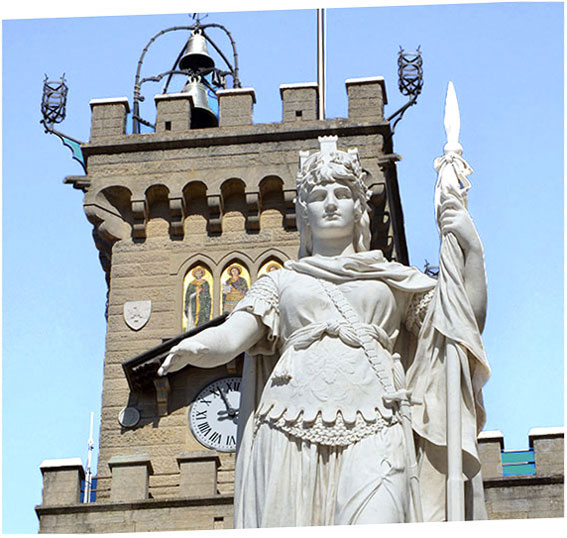
The country of San Marino is a small sovereign state that is part of UNESCO’s World Heritage Sites. Visit it in one day with this tourist guide with a tourist map.
What to see in the Republic of San Marino, today an autonomous state not far from Rimini, a unique world in Italy! Its cultural tradition and values of authenticity, freedom and identity have remained unchanged over the centuries, which is why in 2008 UNESCO included the historic center of San Marino, Borgo Maggiore and Mount Titano on the list of Protected Properties. Here’s a tourist guide with a map to help you make the most of your visit.
Walking through the historic center, a small open-air art museum, means immersing oneself in the Middle Ages and experiencing its timeless charm.
Shopping in San Marino
In the numerous shops of the historic center of San Marino, it is possible to discover truly unique products: characteristic objects of artistic craftsmanship, highly sought-after stamps and precious coins of the Republic, and traditional ceramic creations. Emotions that take the form of ancient objects to desire, to buy, to cherish.
Gastronomy and restaurants
The Republic of San Marino boasts an ancient and authentic peasant and gastronomic tradition, a uniqueness that it has been able to preserve and that today promotes through the Terra di San Marino Consortium. Love and attention for the products of our land have made gastronomy a simple but rich art of traditions renewed over time. Unmistakable flavors, in restaurants a genuine, sober cuisine, combine typicality with quality and keep alive the immense rural heritage of our territory satisfying the most demanding palates.
Cable car ascent
Inaugurated in 1959, renovated in the 1990s, and recently equipped with new cabins that guarantee an even more sensational experience, the cable car is one of the most used means of transportation by tourists and residents to reach the heart of the capital as it connects the historic centers of Borgo Maggiore and San Marino. In less than 2 minutes, you experience a difference in altitude of about 200 meters while admiring incredible views.
Not to be missed
Here is the tourist map in detail:
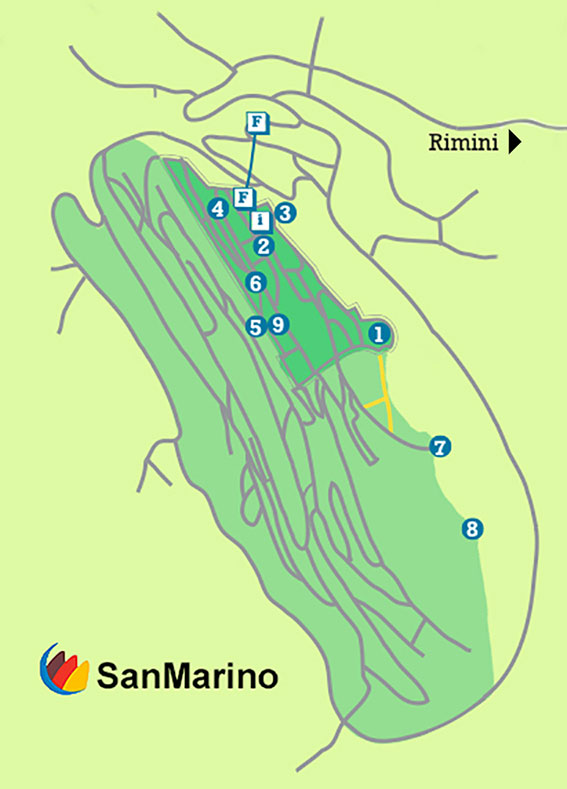
1) First Tower (Guaita) – First Sanmarinese fortress (11th century); since the Statutes of the 1600s, a resident custodian was foreseen whose task was to visually monitor the entire surrounding territory and in case of danger sound the bell of the tower to alert the population. Until the 1960s, the fortress was also used as a prison. In the first inner courtyard, there is the church dedicated to Saint Barbara, patron saint of the artillerymen. The cannons present in the courtyard were donated by Italian kings Vittorio Emanuele II and Vittorio Emanuele III.
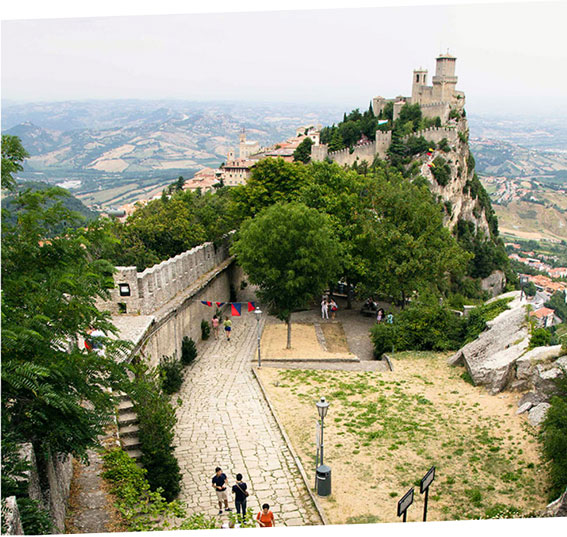
2) Public Palace – Rebuilt in neo-Gothic style in 1894 based on the foundations of the older “Magna Domus Communis.” The clock tower contains a triptych with the images of San Marino, Saint Agatha, and Saint Leo. The Public Palace is the location for official ceremonies and houses the main institutional and administrative organs. In the center of Piazza della Libertà, you can admire the Statue of Liberty (1876), a gift from Countess Otilia Heyroth Wagener.
3) Basilica of San Marino – Built at the beginning of the 19th century in Neoclassical style on the foundations of the pre-existing Romanesque Pieve. The interior has three naves and seven altars; to the left of the main altar is the seat of the Regency, and behind the altar is the statue of San Marino sculpted by Adamo Tadolini in 1830, while a small urn containing the relics of San Marino is in the main altar. To the right of the Basilica is the Church of San Pietro, which houses the two stone beds carved into the rock that tradition indicates as the beds of San Marino and San Leo.

4) National Gallery – Inaugurated on July 7, 2018, on the occasion of the 10th Anniversary of San Marino’s inscription on the UNESCO World Heritage List.
The National Gallery San Marino, the new museum of Modern and Contemporary Art of the Republic of San Marino, has recently reopened to the public with new services and installations. The Logge dei Volontari, a magnificent building from the 1930s renovated for the occasion, hosts the new exhibition path with the most important names in the history of Italian art of the 20th century, from Guttuso to Vedova, from Cagli to Cucchi, from Spagnulo to Chia, from Mari to Ontani.
5) Porta San Francesco – Built in 1361 as a simple guard post, this gate is the official entrance to the historic center of San Marino. Under the vault, two plaques reproduce norms of the Statute related to the defense of the country. The most recent bronze epigraph remembers the inscription of San Marino in the UNESCO World Heritage List.
6) State Museum – It is located in the ancient Palazzo Pergami-Belluzzi. It houses archaeological and artistic artifacts related to the legend of the Holy Founder, the history of the Republic, and its institutions. Don’t miss the entire Sammarinese coinage and medal collection from 1864 to 1937.
7) Second Tower – (Cesta or Fratta) – Second fortress, dating back to the 13th century, on the highest peak of Mount Titano (750 m above sea level). Inside, the Museum of Ancient Weapons from the 13th to the 19th century is located.
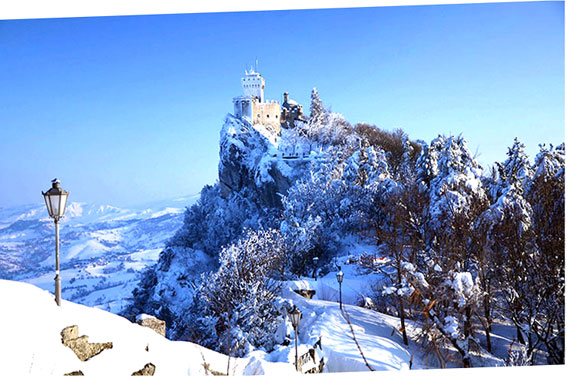
8) Third Tower (Montale) – Third fortress. Watchtower. Although only visitable from the outside, it allows for a suggestive view of the panorama.
9) San Francesco Museum – Located inside the cloister of the church of the same name, built in 1361 by the Comacini Masters. It boasts an important collection of frescoes and paintings.
What else to visit in San Marino?
Passo delle Streghe – (marked in yellow) From the First Tower – Guaita, heading towards the Second Tower – Cesta, you cross the enchanting Passo delle Streghe, which offers wonderful and romantic panoramic views of the Adriatic coast.
Changing of the Guard – The Guardia di Rocca provides an honor service at Palazzo Pubblico, which carries out the Changing of the Guard every day during the summer period, every hour on the half hour. The ceremony represents the formal change of guard.
Naturalistic paths – Green paths, ancient woods, and equipped areas are ideal for enjoying a pleasant break, a walk in the midst of nature along the numerous trails in San Marino’s territory, or simply a bike ride in the enchanting setting of the Apennine hills and Montefeltro.

And for those traveling on a camper, San Marino offers all the necessary services to make the vacation as enjoyable as possible. San Marino Cycling Experience (sanmarinocycling.com), a network that includes five bike hotels, can welcome cyclists with dedicated services to provide a truly unique experience on two wheels. Moreover, the new Ebikexperience project (ebikexperience.it) was recently inaugurated, which offers e-bike rental services and guided tours in nature.
TOURIST OFFICE of San Marino
How to get to San Marino
BY CAR
A14 Bologna-Ancona motorway:
- Exit at Rimini Sud
Rimini-San Marino expressway SS72 - Exit at Rimini Nord
SP “Marecchiese” n° 258
BY TRAIN
Rimini railway station
(with bus connections from Rimini to San Marino)
BY BUS
Linea San Marino – Rimini line
Fratelli Benedettini Spa
Bonelli Bus Sas
The story tells:
The millennia-old history of San Marino is intertwined with the figure of San Marino, its illustrious founder. This small sovereign state, nestled in the Italian peninsula and completely surrounded by Italian territory, boasts a rich legendary tradition, although some details may vary among sources.
According to tradition, San Marino, originally from Rimini in the 4th century AD, left his city in search of a tranquil refuge to practice his Christian faith. He found shelter on Mount Titano, where he led an ascetic life, attracting followers due to his reputation for holiness.
The story of the founding of this republic is often associated with an episode involving Asterius, the governor of Rimini. Refusing to bend to the persecution of Christians, San Marino sought refuge on Mount Titano, gaining the benevolence of Asterius. The community that developed around him became the founding nucleus of the Republic of San Marino.
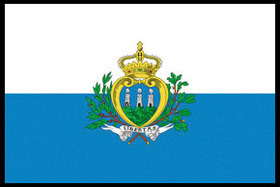
Over the centuries, this community organized itself into a form of republican government based on principles of justice and freedom. Tradition has it that in 301 AD, this saint formally founded his community, marking the beginning of the republic’s history. This republic defended its independence through the ages, resisting the pressures of various conquerors and rulers.
In the Middle Ages, it consolidated its autonomy by forming alliances with other Italian city-states. In the 19th century, it became involved in the struggles for Italian unification but managed to preserve its autonomy. During the Second World War, despite being occupied by Nazi troops, the republic maintained its neutrality.
Today, San Marino is a parliamentary republic with a stable economy, primarily based on tourism, the sale of stamps, and the financial sector. Its unique history and tradition of independence continue to make it a particular case in European history.
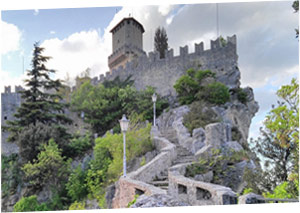
DISCOVERING the historic centre of San Marino with an expert tour guide, exploring the most iconic, scenic, and tradition-rich spots.

